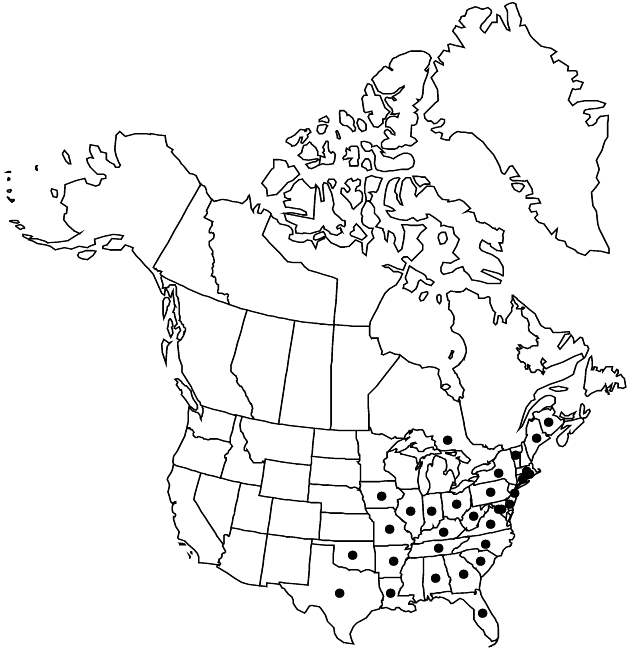Difference between revisions of "Symphyotrichum racemosum"
Phytologia 77: 290. 1995.
FNA>Volume Importer |
imported>Volume Importer |
||
| (3 intermediate revisions by 2 users not shown) | |||
| Line 8: | Line 8: | ||
}} | }} | ||
|common_names=Small white or smooth white oldfield aster | |common_names=Small white or smooth white oldfield aster | ||
| + | |special_status={{Treatment/ID/Special_status | ||
| + | |code=E | ||
| + | |label=Endemic | ||
| + | }} | ||
|basionyms={{Treatment/ID/Basionym | |basionyms={{Treatment/ID/Basionym | ||
|name=Aster racemosus | |name=Aster racemosus | ||
|authority=Elliott | |authority=Elliott | ||
| + | |rank=species | ||
|publication_title=Sketch Bot. S. Carolina | |publication_title=Sketch Bot. S. Carolina | ||
|publication_place=2: 348. 1823 | |publication_place=2: 348. 1823 | ||
| Line 17: | Line 22: | ||
|name=Aster brachypholis | |name=Aster brachypholis | ||
|authority=Small | |authority=Small | ||
| + | |rank=species | ||
}} | }} | ||
|hierarchy=Asteraceae;Asteraceae tribe Astereae;Symphyotrichum;Symphyotrichum subg. Symphyotrichum;Symphyotrichum sect. Symphyotrichum;Symphyotrichum racemosum | |hierarchy=Asteraceae;Asteraceae tribe Astereae;Symphyotrichum;Symphyotrichum subg. Symphyotrichum;Symphyotrichum sect. Symphyotrichum;Symphyotrichum racemosum | ||
| Line 41: | Line 47: | ||
-->{{#Taxon: | -->{{#Taxon: | ||
name=Symphyotrichum racemosum | name=Symphyotrichum racemosum | ||
| − | |||
|authority=(Elliott) G. L. Nesom | |authority=(Elliott) G. L. Nesom | ||
|rank=species | |rank=species | ||
| Line 55: | Line 60: | ||
|publication title=Phytologia | |publication title=Phytologia | ||
|publication year=1995 | |publication year=1995 | ||
| − | |special status= | + | |special status=Endemic |
| − | |source xml=https:// | + | |source xml=https://bitbucket.org/aafc-mbb/fna-data-curation/src/2e0870ddd59836b60bcf96646a41e87ea5a5943a/coarse_grained_fna_xml/V19-20-21/V20_1148.xml |
|tribe=Asteraceae tribe Astereae | |tribe=Asteraceae tribe Astereae | ||
|genus=Symphyotrichum | |genus=Symphyotrichum | ||
Latest revision as of 19:59, 5 November 2020
Perennials, 30–90(–100) cm, colonial or cespitose; long-rhizomatous or with woody caudices. Stems 1–3+, erect (straight), glabrous or glabrate. Leaves thin, margins often ± revolute, scabrous, apices mucronate to mucronulate, faces glabrous or abaxial minutely pilosulous, cauline with clusters of smaller leaves in most axils; basal withering by flowering (new vernal rosettes often present), petiolate (petioles narrowly winged, sheathing, strigoso-ciliate), blades spatulate to oblanceolate, 5–40 × 5–15 mm, bases attenuate or cuneate to rounded, margins crenate-serrate, apices obtuse to acuminate; proximal cauline withering by flowering, petiolate or subpetiolate (proximalmost) or sessile (petioles winged, sparsely long strigoso-ciliate), blades elliptic or elliptic-lanceolate to lanceolate or linear-lanceolate, 20–70 × 3–20 mm, progressively reduced distally, bases clasping, margins becoming short-ciliate distally; distal (ascending or spreading) usually sessile, sometimes subpetiolate, blades linear-lanceolate to linear, 5–60+ × 1–8 mm, notably unequal in size, reduced distally, abruptly so on branches, bases cuneate to attenuate, margins serrulate or entire. Heads in diffuse, ± pyramidal, paniculiform arrays, branches ± lax, spreading horizontally or arching, racemiform, subtended by patent to reflexed branch leaves, often crowded but not (or barely) secund. Peduncles slender, 0.2–3+ cm or subsessile, hairy in lines, bracts 5–15, linear-elliptic to acicular, 1–2 mm, glabrous, grading into phyllaries. Involucres cylindric, (2.5–)3.5–4.5(–5.5) mm. Phyllaries in 4–6 series, appressed or outer ± spreading, oblong-lanceolate to linear (innermost) , unequal, bases indurate 1/4–1/2, margins narrowly scarious, hyaline, ciliolate, green zones oblanceolate to linear-oblanceolate, apices acute to acuminate, mucronate, sometimes lightly purple-tinged, faces glabrous. Ray florets (12–)16–20; corollas usually white, rarely pink, laminae 5–8 × 0.5–1.2 mm. Disc florets 10–20(–25); corollas cream or pale yellow becoming pink or red, (2.5–)3–4.5 mm, tubes shorter than narrowly funnelform throats, lobes recurved to erect, lanceolate, 0.5–1 mm. Cypselae gray to tan, obovoid, ± compressed, 1–1.8 mm, 4–5-nerved (faint), faces sparsely strigillose or sericeus; pappi white, 2.5–3.5 mm. 2n = 16.
Phenology: Flowering Aug–Oct.
Habitat: Moist to wet, often alluvial soils, often brackish, marshes, savannas, bogs, wet meadows, prairie swales, swamps, borders of swamps, open bottomwoods
Elevation: 0–200 m
Distribution

N.B., Ont., Ala., Ark., Conn., Del., D.C., Fla., Ga., Ill., Ind., Iowa, Ky., La., Maine, Md., Mass., Mo., N.J., N.Y., N.C., Ohio, Okla., Pa., R.I., S.C., Tenn., Tex., Vt., Va., W.Va.
Discussion
Symphyotrichum racemosum is introduced in Canada. The species is cultivated commercially under the name Aster ericoides cv. ‘Spray’. A. G. Jones (1989) reported hybridization with S. dumosum, S. lateriflorum, S. lanceolatum var. interior, and S. ontarionis. The name Aster vimineus Lamarck has been misapplied to this taxon.
Selected References
None.